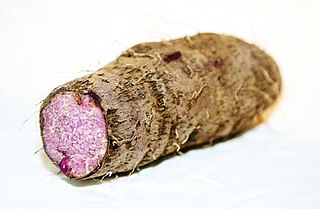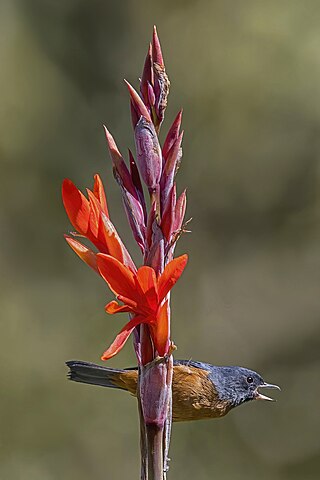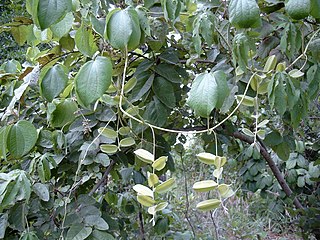
Maranta arundinacea, also known as arrowroot, maranta, West Indian arrowroot, obedience plant, Bermuda arrowroot, araru, araruta, ararao or hulankeeriya, is a large, perennial herb found in rainforest habitats of the Americas, but cultivated in tropical regions worldwide.

Pachyrhizus is a genus of flowering plants in the legume family, Fabaceae. It includes five or species of herbs and subshrubs native to the tropical and subtropical Americas, ranging from northern Mexico to northwestern Argentina. Typical habitat is seasonally-dry tropical forest and thicket, often at forest margins, in scrub vegetation, and in open grassy areas. Plants in the genus grow from large, often edible taproots.

Root vegetables are underground plant parts eaten by humans or animals as food. In agricultural and culinary terminology, the term applies to true roots such as taproots and tuberous roots as well as non-roots such as bulbs, corms, rhizomes, and stem tubers.

Dioscorea alata – also called ube, ubi, purple yam, or greater yam, among many other names – is a species of yam. The tubers are usually a vivid violet-purple to bright lavender in color, but some range in color from cream to plain white. It is sometimes confused with taro and the Okinawa sweet potato beniimo (紅芋), however D. alata is also grown in Okinawa. With its origins in the Asian and Oceanian tropics, D. alata has been known to humans since ancient times.

Nelumbo nucifera, also known as sacred lotus, Indian lotus, or simply lotus, is one of two extant species of aquatic plant in the family Nelumbonaceae. It is sometimes colloquially called a water lily, though this more often refers to members of the family Nymphaeaceae.

Dioscorea communis or Tamus communis is a species of flowering plant in the yam family Dioscoreaceae and is commonly known as black bryony, lady's-seal or black bindweed.

Canna indica, commonly known as Indian shot, African arrowroot, edible canna, purple arrowroot, Sierra Leone arrowroot, is a plant species in the family Cannaceae. It is native to much of South America, Central America, the West Indies, and Mexico. It is also naturalized in the southeastern United States, and much of Europe, sub-Saharan Africa, Southeast Asia, and Oceania.

Yam is the common name for some plant species in the genus Dioscorea that form edible tubers.

Dioscorea polystachya or Chinese yam, also called cinnamon-vine, is a species of flowering plant in the yam family. It is sometimes called Chinese potato or by its Korean name ma. It is also called huaishan in Mandarin and wàaih sāan in Cantonese.

Dioscorea bulbifera is a species of true yam in the yam family, Dioscoreaceae. It is native to Africa, Asia and northern Australia. It is widely cultivated and has become naturalized in many regions.

Dioscorea esculenta, commonly known as the lesser yam, is a yam species native to Island Southeast Asia and introduced to Near Oceania and East Africa by early Austronesian voyagers. It is grown for their edible tubers, though it has smaller tubers than the more widely-cultivated Dioscorea alata and is usually spiny.

Dioscorea trifida is a species of flowering plant in the family Dioscoreaceae. It is a species of yam. It is native to the Caribbean and Central and South America. Its many common names include Indian yam, cush-cush, and yampee. It is called mapuey in Venezuela, inhame in Brazil, tabena and ñame in Colombia, sacha papa in Peru, and ñampi in Costa Rica.

Tacca leontopetaloides is a species of flowering plant in the yam family Dioscoreaceae. It is native to the islands of Southeast Asia. Austronesian peoples introduced it as a canoe plant throughout the Indo-Pacific tropics during prehistoric times. It has become naturalized to tropical Africa, South Asia, northern Australia, and Oceania. Common names include Polynesian arrowroot, Fiji arrowroot, East Indies arrowroot, pia, and seashore bat lily.

Nigeria is by far the world’s largest producer of yams, accounting for over 70–76 percent of the world production. According to the Food and Agriculture Organization report, in 1985, Nigeria produced 18.3 million tonnes of yam from 1.5 million hectares, representing 73.8 percent of total yam production in Africa. According to 2008 figures, yam production in Nigeria has nearly doubled since 1985, with Nigeria producing 35.017 million metric tonnes with value equivalent of US$5.654 billion. In perspective, the world's second and third largest producers of yams, Côte d'Ivoire and Ghana, only produced 6.9 and 4.8 million tonnes of yams in 2008 respectively. According to the International Institute of Tropical Agriculture, Nigeria accounted for about 70 percent of the world production amounting to 17 million tonnes from land area 2,837,000 hectares under yam cultivation.

Dioscorea japonica, known as East Asian mountain yam, yamaimo, or Japanese mountain yam, is a type of yam (Dioscorea) native to Japan, Korea, China, Taiwan, and Assam.

Dioscorea pentaphylla is a species of flowering plant in the yam family known by the common name fiveleaf yam. It is native to southern and eastern Asia as well as New Guinea, Sri Lanka and northern Australia. It is widely cultivated as a food crop and naturalized in Cuba and on several island chains in the Pacific.

Arrowroot is a starch obtained from the rhizomes (rootstock) of several tropical plants, traditionally Maranta arundinacea, but also Florida arrowroot from Zamia integrifolia, and tapioca from cassava, which is often labeled arrowroot. Polynesian arrowroot or pia, from Palawan-Philippines arrowroot ("uraro/araro"), Guyana arrowroot, Japanese arrowroot, also called kudzu, and purple arrowroot Canna indica, are used in similar ways. In Odisha, India, it is called ପାଳୁଅ (paḷua).
Dioscorea zingiberensis, is a species of yam, a tuberous root vegetable. It has been cultivated in China for the production of diosgenin, an important pharmaceutical intermediate for the synthesis of steroid hormones. The rhizomes also produces steroidal saponins (TSS) as part of a treatment for cardiovascular disease.

Dioscorea dumetorum, also known as the bitter yam, cluster yam, trifoliate yam, or three-leaved yam, is a species of flowering plant in the yam family, Dioscorea. It is native to sub-Saharan Africa and especially common in the tropical regions of West Africa, including Nigeria, Benin, and Ghana. D. dumetorum has both toxic and non-toxic varieties.
Dioscorea althaeoides is a herbaceous vine in the genus Dioscorea which is indigenous to the Guizhou, Sichuan, and eastern Xizang provinces of China, in addition to the Yunnan area in Thailand. A formerly unknown acetylated spirostanol saponin, dioscin-6′-O-acetate, has been discovered in the rhizomes of the plant.

















